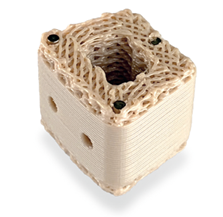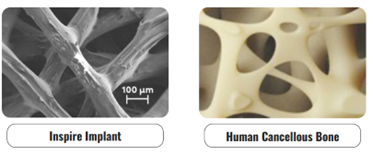Transforming Spinal Surgery with 3D-Printed PEEK Implants

The successful use of 3D-printed polyether ether ketone (PEEK) spinal implants highlights the powerful role of additive manufacturing in complex medical treatments.
These implants, developed with Evonik’s VESTAKEEP i4 3DF PEEK polymer, represent a breakthrough in spinal fusion technology by offering enhanced osseointegration, biocompatibility, and structural integrity critical for complex spinal procedures.
You can also read: Evonik Claims First Carbon Fiber PEEK for Printing Implants
PEEK’s Promise in Spinal Implants
PEEK’s biocompatibility, strength, and radiolucency make it highly desirable in spinal surgeries. Unlike traditional materials like titanium, PEEK’s modulus of elasticity closely resembles that of bone, which helps reduce stress shielding.
This similarity in mechanical properties facilitates better load distribution, reducing complications associated with bone resorption around the implant.
Furthermore, PEEK is radiolucent, meaning it does not interfere with imaging techniques, allowing surgeons to monitor the healing process and verify bone integration over time without visual obstructions.
3D Printing and Enhanced Osseointegration

The Curiteva Inspire implant. Courtesy of Curiteva.com
Traditional PEEK implants face limitations in achieving deep osseointegration due to their solid structure, which restricts bone growth beyond the implant’s surface.
The Curiteva Inspire implant, a fully 3D-printed, trabecular-like structure, addresses this issue by promoting deep bone integration throughout the implant.
The interconnected porous design of the Inspire® implant mimics trabecular bone, providing ample space for endplate-implant osseointegration and enhanced bone penetration, a feature unattainable with conventional PEEK implants.
Evonik’s VESTAKEEP i4 3DF PEEK polymer used in these implants was specifically engineered for additive manufacturing, making it possible to fabricate complex, customized structures with high accuracy and consistency.
The fused strand deposition technique in the 3D printing process ensures that the implant maintains its structural integrity while allowing extensive bone growth, offering an advantage in complex multi-level spinal fusions.
Clinical Success and Future Prospects
The initial surgeries with 3D-printed PEEK spinal implants signify a promising advancement in spinal fusion procedures. Early outcomes have demonstrated substantial bone integration across the implant, importantly without the PEEK “halo effect.” This effect, common in traditional PEEK implants, creates a radiolucent zone around the implant, often indicating poor osseointegration.
Additionally, with no reported instances of implant loosening or migration, these implants exhibit strong potential to enhance patient outcomes in multi-level fusion surgeries.

Structure Designed to Mimic the Morphology of Cancellous Bone. Courtesy of Curiteva.com
As the medical field advances 3D printing technology, PEEK spinal implants will likely play a crucial role in transforming spinal surgery. Furthermore, ongoing developments in biomaterials, such as VESTAKEEP, could lead to broader applications of 3D-printed implants. These advancements may expand into other complex orthopedic procedures where patient-specific solutions are vital.
